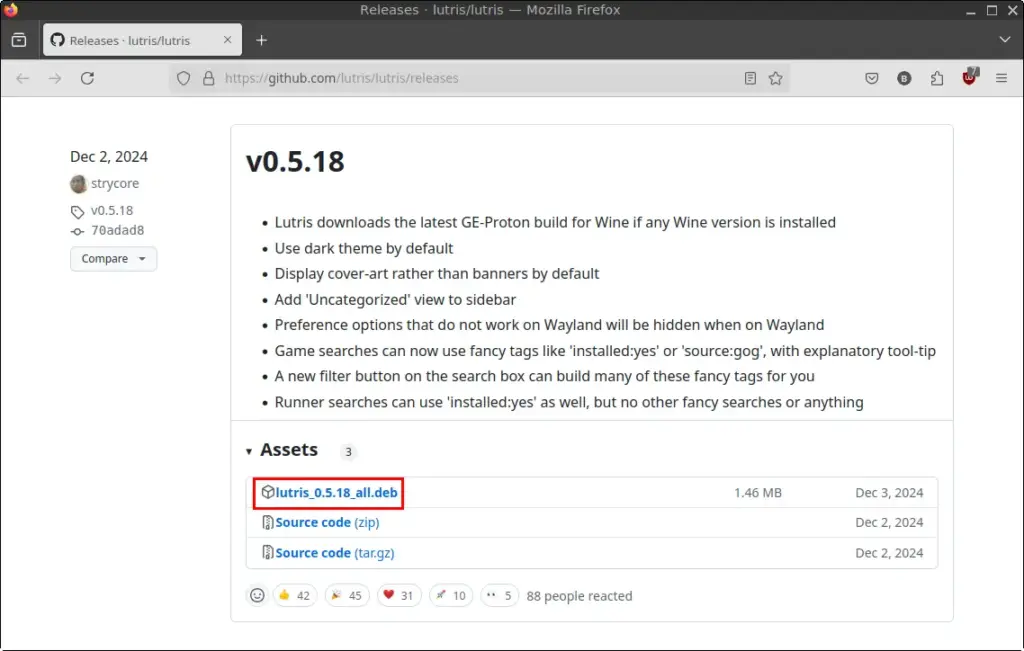What is Lutris?
Lutris is an open-source gaming platform designed to simplify and enhance gaming on Linux. It acts as a comprehensive game manager, providing a unified interface for organizing and launching games from a variety of sources, including native Linux titles, Windows games (via Wine), emulators, and web-based games. Lutris also integrates with popular digital distribution platforms like Steam and GOG, allowing users to manage their entire game library in one place.
Key features of Lutris include:
- Unified Game Library: Centralized management of games from multiple platforms.
- Compatibility Layers: Support for running Windows games on Linux using Wine.
- Emulator Integration: Seamless handling of retro games through various emulators.
- Automated Setup: Installation scripts to simplify game setup and configuration.
- Store Integration: Connect with Steam, GOG, Humble Bundle, and more for easy access to purchased games.
By streamlining the gaming experience on Linux, Lutris aims to make gaming accessible and enjoyable for users of all skill levels.

How to Install Lutris on FunOS
Lutris can be installed on FunOS using several methods. Below are the most common and reliable ways to get Lutris up and running on your system.
Method 1
In this first method, we will install Wine and Lutris from the Ubuntu repository. To run Windows games, we need Wine. This first method is the easiest. But the Wine and Lutris versions are not the latest.
Install Wine from the Ubuntu Repositories
1. Open a Terminal
2. Enable 32 bit architecture:
sudo dpkg --add-architecture i3863. Update the package list:
sudo apt update4. Install Wine:
sudo apt install wineInstall Lutris from the Ubuntu Repositories
1. Open a Terminal
2. Update the package list:
sudo apt update3. Install Lutris:
sudo apt install lutris4. Click the menu in the bottom left corner of the screen. Next, click the Reload menu. The objective is to display Lutris in the menu.

Method 2
In this second method, we will install Wine from the official Wine repository. We will also install Lutris using the DEB package from the official Lutris release on GitHub. This second method is the best method. We will get the latest version of Wine and Lutris.
Install Wine from the Wine Repositories
1. Open a Terminal
2. Enable 32 bit architecture:
sudo dpkg --add-architecture i3863. Update the package list:
sudo apt update4. Install the necessary dependencies:
sudo apt install apt-transport-https5. Add Wine GPG Key:
wget -O - https://dl.winehq.org/wine-builds/winehq.key | sudo gpg --dearmor -o /etc/apt/keyrings/winehq-archive.key -6. Add the Wine Repository:
sudo wget -NP /etc/apt/sources.list.d/ https://dl.winehq.org/wine-builds/ubuntu/dists/$(lsb_release -cs)/winehq-$(lsb_release -cs).sources7. Update the package list:
sudo apt update8. Install Wine:
sudo apt install --install-recommends winehq-stable9. Install the necessary dependencies:
sudo apt install winetricksInstall Lutris using the .deb package from Lutris Releases on GitHub
1. Download the Lutris .deb package:
Go to the Lutris Releases Page on GitHub and download the latest .deb package.
Save the file to your Downloads directory.

2. Navigate to the Downloads directory:
cd ~/Downloads3. Install the package:
sudo apt install ./lutris_*.deb4. Remove the downloaded Lutris .deb package:
rm -f lutris_*.deb5. Click the menu in the bottom left corner of the screen. Next, click the Reload menu. The objective is to display Lutris in the menu.

Launching Lutris
After the installation is complete, you can launch Lutris from the application menu or by typing lutris in the terminal.

How to Uninstall Lutris on FunOS
Uninstalling Lutris is just as simple as installing it. Here are the steps based on the installation method you used:
Uninstall Lutris installed by Method 1
Uninstall Wine
1. Open a Terminal
2. Remove Wine:
sudo apt remove --purge wine3. Remove any unused dependencies:
sudo apt autoremove --purgeUninstall Lutris
1. Open a Terminal
2. Remove Lutris:
sudo apt remove --purge lutris3. Remove any unused dependencies:
sudo apt autoremove --purge4. Remove user data (optional):
rm -rf $HOME/.config/lutris*
rm -rf $HOME/.cache/lutris
rm -rf $HOME/.local/share/lutris5. Click the menu in the bottom left corner of the screen. Next, click the Reload menu. The objective is to remove Lutris from the menu.

Uninstall Lutris installed by Method 2
Uninstall Wine
1. Open a Terminal
2. Remove Wine and winetricks :
sudo apt remove --purge winehq-devel winetricks3. Remove any unused dependencies:
sudo apt autoremove --purge4. Remove the repository and key (optional):
sudo rm -f /etc/apt/sources.list.d/winehq-$(lsb_release -cs).sources
sudo rm -f /etc/apt/keyrings/winehq-archive.key 5. Update the package list:
sudo apt updateUninstall Lutris
1. Open a Terminal
2. Remove Lutris:
sudo apt remove --purge lutris3. Remove any unused dependencies:
sudo apt autoremove --purge4. Remove user data (optional):
rm -rf $HOME/.config/lutris*
rm -rf $HOME/.cache/lutris
rm -rf $HOME/.local/share/lutris5. Click the menu in the bottom left corner of the screen. Next, click the Reload menu. The objective is to remove Lutris from the menu.

Conclusion
Lutris is an invaluable tool for Linux gamers, offering a versatile and user-friendly platform for managing games across different systems and formats. Its support for compatibility layers like Wine, integration with major gaming stores, and ease of use make it a must-have for any Linux gaming enthusiast. Whether you’re installing it for the first time or removing it, the process is straightforward and well-supported, making Lutris a convenient choice for enhancing your gaming experience on FunOS.

Leave a Reply